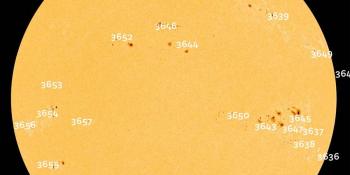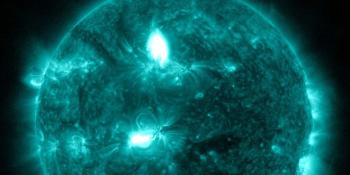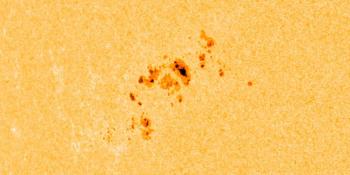Affichage des archives de mardi, 21 octobre 2003
Rapport d'activité solaire
Any mentioned solar flare in this report has a scaling factor applied by the Space Weather Prediction Center (SWPC). Because of the SWPC scaling factor, solar flares are reported as 42% smaller than for the science quality data. The scaling factor has been removed from our archived solar flare data to reflect the true physical units.
Rapport d'activité solaire et géophysique 2003 Oct 21 2200 UTCFait par le NOAA © SWPC et adapté par SpaceWeatherLive.com
Rapport de l'USAF/NOAA sur l'activité solaire et géophysique
SDF numéro 294 publié à 2200Z le 21 Oct 2003IA. Analyse des régions solaires actives et activité du 20-2100Z au 21-2100Z Solar activity has been moderate. There has been a
steady series of C-class flares and a single M1.0 at 21/0827 UTC.
Region 484 (N05E26) continues to grow, but at a lesser rate than
yesterday. The region is now 1650 millionths with at least a 50%
increase in magnetic intensity. A region just beyond the East limb,
generated a strong CME at approximately 21/0300 UTC, but does not
appear to be Earth-directed.
IB. Prévisions d'activité solaire
Solar activity is expected to remain
moderate. Region 484, and the new Region approaching the East limb,
are a combined threat to continue to generate C-class activity, with
an occasional M-class flare. There is a slight chance for an
isolated X-class event, and an even lesser chance for a
proton-producing flare. By day three, Region 484 will near central
meridian, and become a slightly higher threat for producing a flare
event which could generate protons at near-Earth.
IIA. Résumé de l'activité géophysique du 20-2100Z au 21-2100Z
The geomagnetic field has been at active to minor storm levels. A
favorably positioned coronal hole is supporting a high-speed solar
wind stream, which is in turn supporting elevated magnetic activity
at Earth. The greater than 2 MeV electron flux at geosynchronous
orbit reached high levels today.
IIB. Prévision de l'activité géophysique
The geomagnetic field is
expected to be at active to minor storm levels for the next three
days. The coronal hole will proceed out of geoeffective range
around the second day, but a faint shock associated with a CME which
occurred on the 19th should lightly impact Earth, once again
elevating magnetic activity on day three.
III. Probabilité d'éruption solaire du 22 Oct au 24 Oct
| Classe M | 70% | 70% | 70% |
| Classe X | 15% | 15% | 15% |
| Proton | 10% | 10% | 15% |
| PCAF | green | ||
IV. Flux Penticton 10.7 cm
Observé 21 Oct 152 Prévisionnel 22 Oct-24 Oct 150/155/160 Moyenne des 90 derniers jours 21 Oct 114
V. Indice géomagnetique A
Observé Afr/Ap 20 Oct 020/030 Estimé Afr/Ap 21 Oct 028/030 Prévisionnel Afr/Ap 22 Oct-24 Oct 020/025-020/020-025/020
VI. Probabilités d'activité géomagnétique du 22 Oct au 24 Oct
| A. Latitudes moyennes | |||
|---|---|---|---|
| Actif | 35% | 35% | 30% |
| Tempête mineure | 30% | 30% | 35% |
| Tempête majeure/sévère | 10% | 10% | 15% |
| B. Hautes latitudes | |||
|---|---|---|---|
| Actif | 25% | 25% | 25% |
| Tempête mineure | 35% | 30% | 35% |
| Tempête majeure/sévère | 15% | 10% | 15% |
Dernières nouvelles
Forum
IMF - BT strength 6AR3654 1What are these long and thin eruptions? 6AR 3637, 3638, 3643 89Unproven theories 341
Plus de messages du forumAidez SpaceWeatherLive.com !
Vous êtes de plus en plus nombreux à consulter SpaceWeatherLive pour suivre l'activité solaire ou aurorale, et avec le traffic les coûts du serveur augmentent. Si vous appréciez SpaceWeatherLive, soutenez notre projet en faisant un don afin que nous puissions continuer à vous informer !

La Météo Spatiale en faits
| Dernière classe X | 28/03/2024 | X1.1 |
| Dernière classe M | 25/04/2024 | M1.3 |
| Dernier orage géomagnétique | 19/04/2024 | Kp7 (G3) |
| Jours sans taches solaires | |
|---|---|
| Dernier jour sans taches solaires | 08/06/2022 |
| Nombre mensuel moyen de taches solaires | |
|---|---|
| mars 2024 | 104.9 -19.8 |
| Last 30 days | 135.5 +27.6 |


